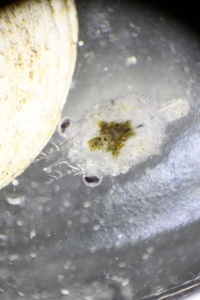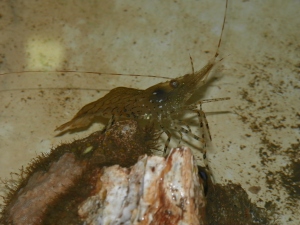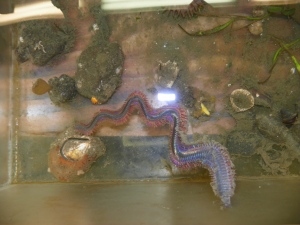
Figure 1: The LED nightlight, just below the surface draws in a couple fast-swimming nereids and a shrimp of the Pandalus genus.
Night Lighting at Friday Harbor Laboratories
By Dan Lombardo
The bulky power supply is connected to the 24” tube of super-bright LEDs, causing students to cry out and cover their eyes, surprised and momentarily stunned by the blinding white flash.

Figure 2: A tiny megalopan larvae that turned out, a few days later, to be a crab of the Cancer genus.
It’s a dark, clear evening, and the nightlight is slowly being lowered off of the floating dock and into the waters of Friday Harbor. As the afterimages fade, a new world is revealed: In this world, tiny animals (probably ostracods) race through tight curves beneath the surface like turbo-charged sesame seeds. The eerie glow of the nightlight is surrounded and smothered in swarms of nauplii (an early larval stage of some crustaceans), while larger and less numerous, the pea-sized final stage of decapod larvae, the megalopa, drift along, their tiny pereopods outstretched in a chibi caricature of adulthood.
Deeper down, just below the nightlight, a churning school of Sandlance, Ammodytes hexapterus, the “potato chip” of the Salish Sea, is beginning to assemble.
As the ebb-tide drains the harbor it brings other planktonic drifters into the submarine halo; Ctenophores (or “comb jellies” if you prefer), of the Bolinopsis and Pleurobrachia genera cruise by, navigating the current with their eight rows of fused cilia in search of prey. Medusoid hydrozoans, Mitrocoma and Aequoria, like living glass paperweights, pulsate in the moving water column. As Aqueoria drifts out of the light and toward San Juan Channel, a sudden blue-green flash indicates that its hunt has been successful; its tightly coiled cnidocysts are deployed at amazing speed, impaling and envenomating its planktonic quarry in a horror-movie scene that is thankfully invisible to the naked eye.
Coon-stripe shrimp, Pandalus danae, crawl, swim, and dart in typical caridoid fashion along the edges of the floating dock. They are beautifully unaware of our 2-dimensional terrestrial world, and orient themselves in the water column without regard for the illusions of “up” and “down”. The relative silence is suddenly broken as voices raise to a shout: The creature many of us have been hoping to see is coming into view; writhing and undulating, out of the darkness below, a huge Nereid worm! The 50cm long giant winds its way through the scene, blindly crashing into the light, the dock, the shrimps, and anything else in its path, in its eagerness to spawn. This specimen is clearly male, indicated by the milky trail of sperm it leaves behind; the skywriting of a perverted barnstormer, desperately seeking a mate before its terminal disintegration.
The best (or easiest to catch) specimens of numerous crustacean larvae, polychaete worms (including our lusty monster Nereid), a few ctenophores, an Aqueoria, and some total unknowns are transferred to our collection jars and buckets and taken to the labs for later evaluation. It has been a productive evening, and I am looking forward to the chance to practice my diagrammatic drawing during tomorrow’s lab. While it’s poorly understood why marine animals are drawn to the nightlight, my own attraction is clear: The nightlight opens the door to an entirely new and fascinating world, a world seldom seen or appreciated by those who aren’t a part of it. The cryptic nocturnal realm floating just beneath my feet reminds me that there is always more to learn, that the world Is not a simple place, and that the seemingly important complications of my everyday life pale in comparison to the desperate struggles of the quadrillions of tiny creatures more numerous than myself. It is a scene to be appreciated with awe and humility.
|
Animals Collected and Identified While Nightlighting in Friday Harbor |
||||
| Phylum | Class | Order | Family | Genus/Species |
| Annelida | Errantia | Phyllodocida | Nereidae | Neanthes Brandti |
| Arthropoda | Malacostraca | Decapoda | Pandalidae | Pandalus danae |
| Cancridae | Cancer spp. | |||
| Cnidaria | Hydrozoa | Leptomedusae | Aequoriedae | Aequoria spp. |
| Mitrocomidae | Mitrocoma cellularia | |||
| Ctenophora | Tentaculata | Cydippida | Pleurorachiidae | Pleurobrachia bachei |
| Lobata | Bolinopsidae | Bolinopsis infundibulum | ||


